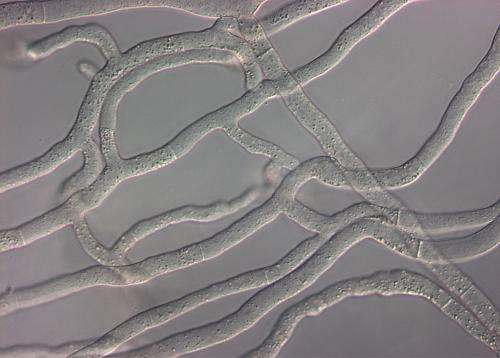Gap closed in the genetic map of kingdom fungi

An international research team headed by PD Dr Minou Nowrousian from the Ruhr-Universität Bochum (RUB) has sequenced the genome of the ascomycete Pyronema confluens, thus closing a gap in the genetic map of fungi. For the first time, scientists have shown for fungi that, in the entire genome, those genes that are active during the sexual development evolve more rapidly than other genes. A similar effect was already described for animals and plants; for fungi, however, this question had hardly been addressed at all. The team from Germany, Spain and the USA has published their findings in PLoS Genetics.
Pyronema – a typical representative of its systematic group
Today, the genomes of more than 250 fungi have been sequenced. Among the basal filamentous ascomycetes – a group of ascomycetes that includes e.g. truffles and morels – only one representative has been analysed so far: the truffle Tuber melanosporum. "With 125 million base pairs, the truffle genome is unusually big, yet it is coding for relatively few genes, namely some 7,500," says Minou Nowrousian from the Department of General and Molecular Botany. "Until now, it was not clear whether this is typical of basal filamentous ascomycetes or whether it is caused by the truffle's 'atypical' lifestyle." Unlike other filamentous ascomycetes, the truffle does not develop reproductive organs – so-called fruiting bodies – above ground but rather below ground. Moreover, it only grows in symbiosis with plant roots (mycorrhiza). Pyronema, on the other hand, is a typical representative of its group.
Intermediary evolutionary stage
The genome of Pyronema confluens contains 50 million base pairs and some 13,000 genes; it is thus smaller than that of the truffle, and yet it contains more genes. These findings confirm the truffle's special position and provide new insights into the evolution of ascomycetes. "Pyronema confluens bears a stronger resemblance to higher ascomycetes than to the truffle," concludes Minou Nowrousian. However, the scientists have also discovered differences to higher ascomycetes, for example in the DNA sequence containing the genetic blueprint for mating type genes. Mating type genes are the main regulators of sexual development and, in Pyronema confluens, they do not show the standardised structure that is typical for higher ascomycetes. "Pyronema confluens may represent an intermediary evolutionary stage in the evolution of mating type genes," says the Bochum biologist.
Light-activated genes
One characteristic feature of the fungus under investigation is the fact that it produces fruiting bodies only in light. Fittingly, the researchers discovered genes in the Pyronema genome containing blueprints for photoreceptors for different wavelengths of visible light. The activity of some of those genes increased in light.
More information: Traeger S, et al. (2013) The genome and development-dependent transcriptomes of Pyronema confluens: a window into fungal evolution, PLoS Genet 9(9): e1003820. DOI: 10.1371/journal.pgen.1003820
Journal information: PLoS Genetics
Provided by Ruhr-Universitaet-Bochum




















